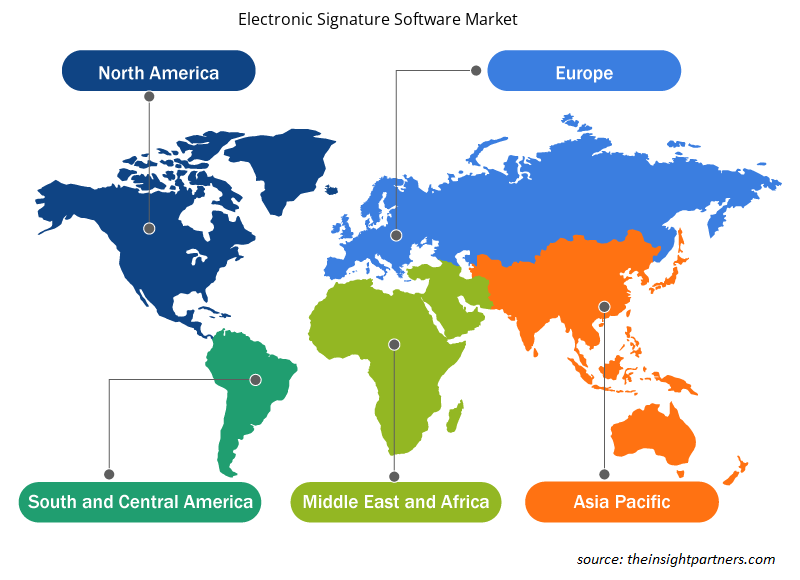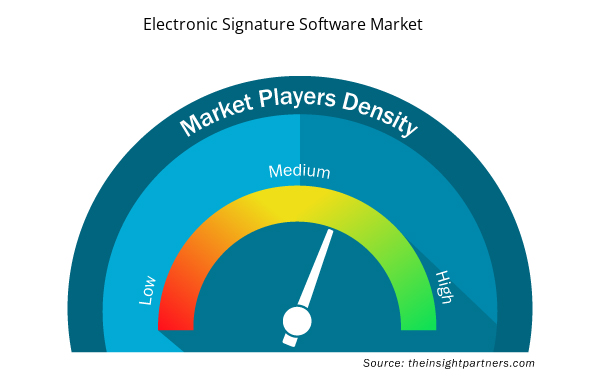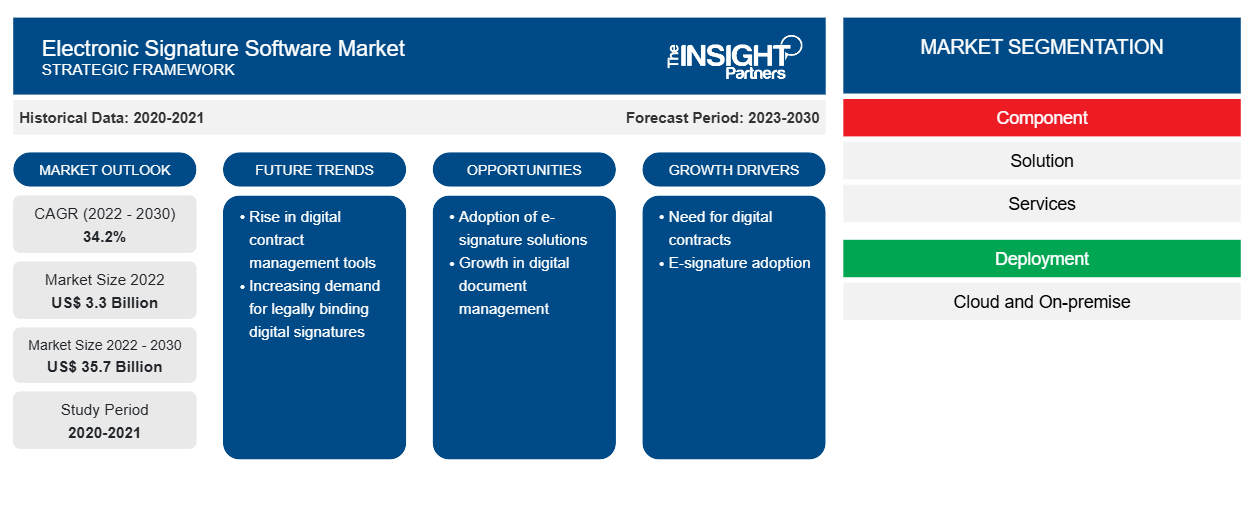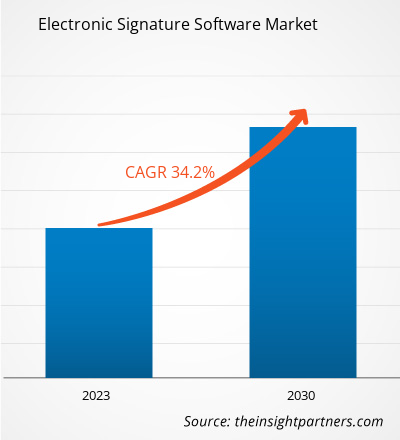[تقرير بحثي] بلغت قيمة سوق برامج التوقيع الإلكتروني 3.3 مليار دولار أمريكي في عام 2022 ومن المتوقع أن تصل إلى 35.7 مليار دولار أمريكي بحلول عام 2030؛ ومن المتوقع أن تسجل معدل نمو سنوي مركب بنسبة 34.2٪ من عام 2022 إلى عام 2030.
وجهة نظر المحلل:
تعتبر التوقيعات الإلكترونية، مثل التوقيعات السحابية، أكثر أنواع التوقيع الإلكتروني أمانًا في جميع أنحاء العالم. عندما تحتاج مؤسسة أو فرد إلى أعلى مستوى من الضمان لتحديد هوية الموقِّع، فيمكنه حماية معاملاته أو الامتثال للقوانين المحلية من خلال اختيار توقيع إلكتروني يستخدم هوية رقمية تم التحقق منها من قبل طرف ثالث موثوق به. تشمل بعض العوامل الرئيسية التي تساهم في نمو سوق برامج التوقيع الإلكتروني زيادة الرقمنة والتقدم في التكنولوجيا والتركيز المتزايد للشركات على تقديم خدمات شاملة أفضل. على نطاق عالمي، تعد التصنيع والخدمات المصرفية والمالية والتأمين والأدوية والوكالات الحكومية والقانونية من بين الصناعات الرئيسية التي تتصدر إنفاق برامج التوقيع الإلكتروني في جميع أنحاء العالم.
نظرة عامة على سوق برامج التوقيع الإلكتروني:
التوقيع الإلكتروني هو وسيلة فعالة وقانونية لتوقيع المستندات الإلكترونية بسرعة. إنه نظام آمن وموثوق به يمكن أن يحل محل التوقيع المكتوب بخط اليد في العديد من العمليات. يوفر التوقيع الإلكتروني أمانًا فائقًا للطرف الذي يوقع المستندات والطرف الذي يتلقاها. تتمتع المستندات الموقعة إلكترونيًا بإمكانيات أكبر في القطاع القانوني، وهو عامل رئيسي يدعم نمو سوق برامج التوقيع الإلكتروني. توفر برامج التوقيع الإلكتروني العديد من المزايا التي تمكن الشركات من تبسيط سير العمل. تشمل مزايا التوقيعات الإلكترونية زيادة سرعة الأعمال وتحسين دقة المستندات وتحسين التكلفة والوقت وتحسين خدمة العملاء، من بين أمور أخرى.
قم بتخصيص هذا التقرير ليناسب متطلباتك
ستحصل على تخصيص لأي تقرير - مجانًا - بما في ذلك أجزاء من هذا التقرير، أو تحليل على مستوى الدولة، وحزمة بيانات Excel، بالإضافة إلى الاستفادة من العروض والخصومات الرائعة للشركات الناشئة والجامعات
- احصل على أهم اتجاهات السوق الرئيسية لهذا التقرير.ستتضمن هذه العينة المجانية تحليلاً للبيانات، بدءًا من اتجاهات السوق وحتى التقديرات والتوقعات.
العوامل المحركة لسوق برامج التوقيع الإلكتروني:
تزايد اعتماد الشركات على التقنيات الرقمية
تشهد برامج التوقيع الإلكتروني زيادة في التبني في كل المؤسسات العامة والخاصة. تتطلب البنوك الدولية والوطنية والمكاتب الحكومية والشركات الصغيرة والمتوسطة الحجم وغيرها التوقيعات الرقمية لحماية البيانات الهامة والتحكم فيها. تستخدم العديد من الشركات التوقيعات الرقمية لتجنب خروقات البيانات وضمان تفاعلات موثوقة مع شركائها التجاريين والإجراءات الداخلية. ويدعم هذا أيضًا المستهلكون الأصغر سنًا، الذين يدمجون بشكل متزايد حلول التوقيع الرقمي في حياتهم اليومية. على سبيل المثال، وفقًا لبحث Adobe 2020، كان أكثر من 61٪ من عملاء Adobe في منطقة آسيا والمحيط الهادئ من جيل الألفية من عام 2019 إلى عام 2020.APAC were millennials from 2019 to 2020.
علاوة على ذلك، تعمل الشركات التي لديها موظفون وفروع تقع في مواقع مختلفة في جميع أنحاء العالم على زيادة استخدام التوقيعات الإلكترونية في عملياتها. يساعدهم ذلك على تقليل الوقت من خلال القضاء على الحاجة إلى طباعة المستندات ونقلها للموافقة عليها. كما أنه ليس من السهل تخزين واسترجاع المستندات المادية على المدى الطويل. وفقًا لتقرير اتحاد غرف التجارة والصناعة الهندية (FICCI) اعتبارًا من أكتوبر 2023، أفاد حوالي 35٪ من المستجيبين بانخفاض في تكاليف التشغيل السنوية بنسبة 11-20٪ نتيجة للرقمنة. تعمل الشركات على تحويل أعمالها رقميًا للتنافس بشكل فعال في العصر الرقمي. وبالتالي، فإن التبني المتزايد للتقنيات الرقمية من قبل الشركات يدفع نمو سوق برامج التوقيع الإلكتروني.
تحليل شريحة سوق برامج التوقيع الإلكتروني:
يتم تصنيف سوق برامج التوقيع الإلكتروني على أساس المكون والنشر والطريقة والمستخدم النهائي. بناءً على النشر، ينقسم سوق برامج التوقيع الإلكتروني إلى السحابة والمحلية. بناءً على العرض، ينقسم سوق برامج التوقيع الإلكتروني إلى حلول وخدمات. بناءً على الطريقة، يتم تصنيف سوق برامج التوقيع الإلكتروني إلى توقيع إلكتروني عام وتوقيع إلكتروني مؤهل وتوقيع إلكتروني محسن. بناءً على المستخدم النهائي، يتم تصنيف سوق برامج التوقيع الإلكتروني إلى BFSI وصيدلانية وتصنيع ووكالات حكومية وقانونية وغيرها. من حيث الجغرافيا، يتم تقسيم السوق إلى خمس مناطق رئيسية، بما في ذلك أمريكا الشمالية ومنطقة آسيا والمحيط الهادئ وأوروبا والشرق الأوسط وأفريقيا وأمريكا الجنوبية.
تركز الشركات في سيناريو السوق الحالي على تبني حلول فعالة من حيث التكلفة توفر ميزات إضافية مع تعزيز سلامة البيانات وشفافية أكبر. تستخدم كيانات مختلفة في جميع أنحاء العالم حلول التوقيع الإلكتروني. على سبيل المثال، في نوفمبر 2023، اعتمدت Lion Travel حل التوقيع الإلكتروني DottedSign الذي يساعد الشركة على تحقيق طريقة أكثر كفاءة وملاءمة واستدامة لتوقيع عقود السفر، ومن المتوقع أن يؤدي ذلك إلى توفير سنوي للورق يبلغ حوالي 4.5 طن متري. وبالتالي، فإن مثل هذه الحالات تدفع نمو سوق برامج التوقيع الإلكتروني لقطاع الحلول.
تحليل إقليمي لسوق برامج التوقيع الإلكتروني:
بلغت قيمة سوق برامج التوقيع الإلكتروني في أوروبا 1.01 مليار دولار أمريكي في عام 2022 ومن المتوقع أن تصل إلى 11.03 مليار دولار أمريكي بحلول عام 2030؛ ومن المتوقع أن تسجل معدل نمو سنوي مركب بنسبة 34.7٪ من عام 2022 إلى عام 2030. ينقسم سوق برامج التوقيع الإلكتروني في أوروبا إلى فرنسا وألمانيا وروسيا وإيطاليا والمملكة المتحدة وبقية أوروبا. في التشريع الأوروبي، تم الاعتراف بالتوقيعات الإلكترونية لأول مرة من خلال التوجيه بشأن الإطار المجتمعي للتوقيعات الإلكترونية المعتمد في عام 1999. في أوروبا، في يوليو 2016، أنشأت لائحة خدمات الهوية الإلكترونية والثقة (eIDAS) هيكلًا قانونيًا للتوقيعات والوثائق الإلكترونية في جميع أنحاء الاتحاد الأوروبي. منذ يوليو 2016، تخضع التوقيعات الإلكترونية في المنطقة للوائح خدمات الهوية الإلكترونية والثقة (eIDAS)؛ فهي توفر بيئة تنظيمية قابلة للتطبيق مباشرة على جميع الدول الأعضاء في الاتحاد الأوروبي للسماح بالتفاعلات الإلكترونية السلسة والآمنة بين المواطنين والشركات والسلطات العامة. ويوفر هذا أيضًا للشركات بيئة قانونية متوقعة لتطوير وتوسيع استخدام التوقيعات الإلكترونية في المنطقة.
تحليل اللاعب الرئيسي:
ويستند تحليل سوق برامج التوقيع الإلكتروني على الأداء السنوي للاعبين الرئيسيين مثل Adobe Inc.؛ وDocusign, Inc.؛ وEsign Genie؛ وHID Global؛ وLegalesign Limited؛ وOneSpan؛ وRPost؛ وThales SA؛ وU-SIGN-IT؛ وZoho Corporation.تم تحليل العديد من اللاعبين الآخرين في سوق برامج التوقيع الإلكتروني الأساسية للحصول على رؤية شاملة للسوق ونظامه البيئي.
رؤى إقليمية حول سوق برامج التوقيع الإلكتروني
لقد قام المحللون في Insight Partners بشرح الاتجاهات والعوامل الإقليمية المؤثرة على سوق برامج التوقيع الإلكتروني طوال فترة التوقعات بشكل شامل. يناقش هذا القسم أيضًا قطاعات سوق برامج التوقيع الإلكتروني والجغرافيا في جميع أنحاء أمريكا الشمالية وأوروبا ومنطقة آسيا والمحيط الهادئ والشرق الأوسط وأفريقيا وأمريكا الجنوبية والوسطى.

- احصل على البيانات الإقليمية المحددة لسوق برامج التوقيع الإلكتروني
نطاق تقرير سوق برامج التوقيع الإلكتروني
| سمة التقرير | تفاصيل |
|---|---|
| حجم السوق في عام 2022 | 3.3 مليار دولار أمريكي |
| حجم السوق بحلول عام 2030 | 35.7 مليار دولار أمريكي |
| معدل النمو السنوي المركب العالمي (2022 - 2030) | 34.2% |
| البيانات التاريخية | 2020-2021 |
| فترة التنبؤ | 2023-2030 |
| القطاعات المغطاة | حسب المكون
|
| المناطق والدول المغطاة | أمريكا الشمالية
|
| قادة السوق وملفات تعريف الشركات الرئيسية |
|
كثافة اللاعبين في السوق: فهم تأثيرها على ديناميكيات الأعمال
يشهد سوق برامج التوقيع الإلكتروني نموًا سريعًا، مدفوعًا بالطلب المتزايد من جانب المستخدم النهائي بسبب عوامل مثل تفضيلات المستهلكين المتطورة والتقدم التكنولوجي والوعي المتزايد بفوائد المنتج. ومع ارتفاع الطلب، تعمل الشركات على توسيع عروضها والابتكار لتلبية احتياجات المستهلكين والاستفادة من الاتجاهات الناشئة، مما يؤدي إلى زيادة نمو السوق.
تشير كثافة اللاعبين في السوق إلى توزيع الشركات أو المؤسسات العاملة في سوق أو صناعة معينة. وهي تشير إلى عدد المنافسين (اللاعبين في السوق) الموجودين في مساحة سوق معينة نسبة إلى حجمها أو قيمتها السوقية الإجمالية.
الشركات الرئيسية العاملة في سوق برامج التوقيع الإلكتروني هي:
- شركة أدوبي
- دوكوساين، المحدودة
- ايساين جيني
- اتش اي دي العالمية
- ليجاليزاين المحدودة
إخلاء المسؤولية : الشركات المذكورة أعلاه ليست مرتبة بأي ترتيب معين.

- احصل على نظرة عامة على أهم اللاعبين الرئيسيين في سوق برامج التوقيع الإلكتروني
التطورات الأخيرة:
تركز الشركات العاملة في سوق برامج التوقيع الإلكتروني على كل من الاستراتيجيات غير العضوية والعضوية لنمو أعمالها. وفيما يلي قائمة ببعض التطورات الرئيسية الأخيرة التي شهدتها سوق برامج التوقيع الإلكتروني:
- في عام 2023، قامت شركة Adobe Inc بدمج برنامج Acrobat Sign مع Salesforce لمساعدة المؤسسات على العمل بشكل أسرع باستخدام التوقيعات الإلكترونية الموثوقة. يستفيد عملاء Acrobat Sign من خلال السماح لهم بتسجيل الدخول في ثوانٍ من أي جهاز، مما يزيد من الإنتاجية لكل من يشارك في عملية الموافقة.
- في عام 2023، أطلقت شركة DocuSign Inc. حلاً للتحقق من الهوية يعمل بالذكاء الاصطناعي لإجراء فحوصات بيومترية. ويساعد هذا الحل الموقعين على تقديم مستندات هوية صالحة فعليًا أثناء عملية التوقيع.
- التحليل التاريخي (سنتان)، السنة الأساسية، التوقعات (7 سنوات) مع معدل النمو السنوي المركب
- تحليل PEST و SWOT
- حجم السوق والقيمة / الحجم - عالميًا وإقليميًا وقطريًا
- الصناعة والمنافسة
- مجموعة بيانات Excel



Report Coverage
Revenue forecast, Company Analysis, Industry landscape, Growth factors, and Trends

Segment Covered
This text is related
to segments covered.

Regional Scope
North America, Europe, Asia Pacific, Middle East & Africa, South & Central America

Country Scope
This text is related
to country scope.
الأسئلة الشائعة
The global electronic signature software market was estimated to be US$ 3.39 billion in 2022 and is expected to grow at a CAGR of 34.2% % during the forecast period 2023 - 2030.
Rising adoption of digital technologies by enterprises, growing number of green initiatives, and increasing use of electronic signatures in e-commerce industry are some of the drivers for the market.
High implementation of electronic signatures across SMEs is impacting positive impact, which is anticipated to play a significant role in the global electronic signature software market in the coming years.
The key players holding majority shares in the global electronic signature software market are Adobe Inc., Docusign, Inc., Esign Genie, HID Global, and Legalesign Limited.
The incremental growth expected to be recorded for the global electronic signature software market during the forecast period is US$ 32,311.99 million.
The global electronic signature software market is expected to reach US$ 35,707.44 million by 2030.
Trends and growth analysis reports related to Technology, Media and Telecommunications : READ MORE..
The List of Companies - Electronic Signature Software Market
- Adobe Inc.
- Docusign, Inc.
- Esign Genie
- HID Global
- Legalesign Limited
- OneSpan
- RPost
- Thales S.A.
- U-SIGN-IT
- Zoho Corporation
The Insight Partners performs research in 4 major stages: Data Collection & Secondary Research, Primary Research, Data Analysis and Data Triangulation & Final Review.
- Data Collection and Secondary Research:
As a market research and consulting firm operating from a decade, we have published and advised several client across the globe. First step for any study will start with an assessment of currently available data and insights from existing reports. Further, historical and current market information is collected from Investor Presentations, Annual Reports, SEC Filings, etc., and other information related to company’s performance and market positioning are gathered from Paid Databases (Factiva, Hoovers, and Reuters) and various other publications available in public domain.
Several associations trade associates, technical forums, institutes, societies and organization are accessed to gain technical as well as market related insights through their publications such as research papers, blogs and press releases related to the studies are referred to get cues about the market. Further, white papers, journals, magazines, and other news articles published in last 3 years are scrutinized and analyzed to understand the current market trends.
- Primary Research:
The primarily interview analysis comprise of data obtained from industry participants interview and answers to survey questions gathered by in-house primary team.
For primary research, interviews are conducted with industry experts/CEOs/Marketing Managers/VPs/Subject Matter Experts from both demand and supply side to get a 360-degree view of the market. The primary team conducts several interviews based on the complexity of the markets to understand the various market trends and dynamics which makes research more credible and precise.
A typical research interview fulfils the following functions:
- Provides first-hand information on the market size, market trends, growth trends, competitive landscape, and outlook
- Validates and strengthens in-house secondary research findings
- Develops the analysis team’s expertise and market understanding
Primary research involves email interactions and telephone interviews for each market, category, segment, and sub-segment across geographies. The participants who typically take part in such a process include, but are not limited to:
- Industry participants: VPs, business development managers, market intelligence managers and national sales managers
- Outside experts: Valuation experts, research analysts and key opinion leaders specializing in the electronics and semiconductor industry.
Below is the breakup of our primary respondents by company, designation, and region:

Once we receive the confirmation from primary research sources or primary respondents, we finalize the base year market estimation and forecast the data as per the macroeconomic and microeconomic factors assessed during data collection.
- Data Analysis:
Once data is validated through both secondary as well as primary respondents, we finalize the market estimations by hypothesis formulation and factor analysis at regional and country level.
- Macro-Economic Factor Analysis:
We analyse macroeconomic indicators such the gross domestic product (GDP), increase in the demand for goods and services across industries, technological advancement, regional economic growth, governmental policies, the influence of COVID-19, PEST analysis, and other aspects. This analysis aids in setting benchmarks for various nations/regions and approximating market splits. Additionally, the general trend of the aforementioned components aid in determining the market's development possibilities.
- Country Level Data:
Various factors that are especially aligned to the country are taken into account to determine the market size for a certain area and country, including the presence of vendors, such as headquarters and offices, the country's GDP, demand patterns, and industry growth. To comprehend the market dynamics for the nation, a number of growth variables, inhibitors, application areas, and current market trends are researched. The aforementioned elements aid in determining the country's overall market's growth potential.
- Company Profile:
The “Table of Contents” is formulated by listing and analyzing more than 25 - 30 companies operating in the market ecosystem across geographies. However, we profile only 10 companies as a standard practice in our syndicate reports. These 10 companies comprise leading, emerging, and regional players. Nonetheless, our analysis is not restricted to the 10 listed companies, we also analyze other companies present in the market to develop a holistic view and understand the prevailing trends. The “Company Profiles” section in the report covers key facts, business description, products & services, financial information, SWOT analysis, and key developments. The financial information presented is extracted from the annual reports and official documents of the publicly listed companies. Upon collecting the information for the sections of respective companies, we verify them via various primary sources and then compile the data in respective company profiles. The company level information helps us in deriving the base number as well as in forecasting the market size.
- Developing Base Number:
Aggregation of sales statistics (2020-2022) and macro-economic factor, and other secondary and primary research insights are utilized to arrive at base number and related market shares for 2022. The data gaps are identified in this step and relevant market data is analyzed, collected from paid primary interviews or databases. On finalizing the base year market size, forecasts are developed on the basis of macro-economic, industry and market growth factors and company level analysis.
- Data Triangulation and Final Review:
The market findings and base year market size calculations are validated from supply as well as demand side. Demand side validations are based on macro-economic factor analysis and benchmarks for respective regions and countries. In case of supply side validations, revenues of major companies are estimated (in case not available) based on industry benchmark, approximate number of employees, product portfolio, and primary interviews revenues are gathered. Further revenue from target product/service segment is assessed to avoid overshooting of market statistics. In case of heavy deviations between supply and demand side values, all thes steps are repeated to achieve synchronization.
We follow an iterative model, wherein we share our research findings with Subject Matter Experts (SME’s) and Key Opinion Leaders (KOLs) until consensus view of the market is not formulated – this model negates any drastic deviation in the opinions of experts. Only validated and universally acceptable research findings are quoted in our reports.
We have important check points that we use to validate our research findings – which we call – data triangulation, where we validate the information, we generate from secondary sources with primary interviews and then we re-validate with our internal data bases and Subject matter experts. This comprehensive model enables us to deliver high quality, reliable data in shortest possible time.


 احصل على عينة مجانية لهذا التقرير
احصل على عينة مجانية لهذا التقرير